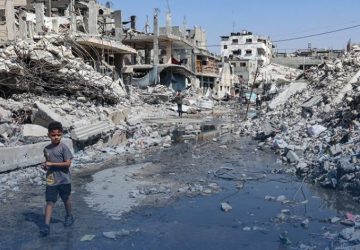Following the assassination of Hamas leader Ismail Haniyeh in Teheran on Wednesday July 31, This is Beirut suggests an in-depth reread of our article on Hamas published the day after the outbreak of the Gaza war.
Listen to the article
Established in 1987 following the initial Intifada against Israel, Hamas’s name derives from “Harakat al-Muqawama al-Islamya” (Islamic Resistance Movement). This group controls the Gaza Strip, a territory that spans 365 square kilometers and is inhabited by 2 million people. Nonetheless, Israel maintains strict control over all entry points, regulating the movement of individuals and goods in and out. Likewise, Egypt maintains strict control over all access points along its border with Gaza.
Formation of Hamas
Hamas was founded in 1987 by Sheikh Ahmed Yasin, an imam afflicted with quadriplegia and trained in Egypt. He embraces the ideology of the Muslim Brotherhood movement, which advocates for a return to religious values following the Arab world’s setbacks against Israel.
Hamas refuses to be a member of the Palestine Liberation Organization (PLO), led by Yasser Arafat. It issues a charter that calls for the elimination of Israel and its replacement with an Islamic State.
The movement rejects the Oslo Accords, signed in 1993 between the PLO and Israel (under the patronage of US President Bill Clinton), which aim to organize a peace process between the two states. These agreements establish the Palestinian Authority (PA), but they are rejected by Hamas. The assassination of Yitzhak Rabin, the Israeli Prime Minister and signatory of the Oslo Accords, on November 4, 1995, by an ultra-nationalist generated Israeli and Palestinian discomfort.
Evolution of Hamas
As successive Israeli governments persist in expanding settlements in the West Bank without adhering to the Oslo Accords’ provisions, Hamas resorts to the use of suicide bombings within Israeli territory. The assassination of several Hamas leaders by Israel, coupled with attacks carried out by Hamas, deepen radicalization on both sides. The Second Intifada in September 2000 exacerbates these deadly confrontations.
In 2004, Sheikh Yasin is killed in an airstrike, despite having declared his movement’s readiness to accept a “hudna” (truce) along the 1967 borders.
Sheikh Yasin’s successors embrace the concept of truce, which leads Hamas to cease suicide bombings in 2005 and to participate in the 2006 legislative elections, while not recognizing the Oslo Accords.
Khaled Mashal, who is one of the movement’s founding members, succeeds Sheikh Yasin. He survives an attempted assassination through poisoning by the Mossad in Jordan.
In 2014, Ismail Haniyeh assumes leadership of Hamas’ political bureau.
Gaza takeover and political developments
During the 2006 legislative elections, the Islamist party prevails over Fatah, a political party derived from the PLO, founded by Yasser Arafat and led by Mahmoud Abbas. Abbas appoints Ismail Haniyeh as Prime Minister, but later dismisses him in 2007.
War erupts between these two Palestinian groups, leading to Hamas taking control of the Gaza Strip while Fatah holds its grip over the West Bank. Numerous attempts at reconciliation between the two parties fail, resulting in the ongoing division of the Palestinian territories.
In response to this victory, Israel and Egypt impose a severe blockade on Gaza, which remains in effect until the present day. Hamas continues to launch rocket attacks into Israeli territory.
In a document published in 2017, the Islamist movement accepts the founding of an interim Palestinian State in Gaza, the West Bank, and East Jerusalem within the 1967 borders.
Internal perceptions
According to a June 2023 survey conducted by the Palestinian Center for Policy and Survey Research, one-third of Palestinians consider the Hamas-Fatah cleavage to be highly detrimental to their people. The survey revealed that over half of Palestinians in Gaza and the West Bank would favor Haniyeh and Hamas over Mahmoud Abbas and Fatah in voting.
Detractors, supporters and financing
Israel and a significant portion of the Western world regard Hamas and its armed wing, known as the Izz al-Din Al-Qassam Brigades, as terrorist organizations. Hamas is also a member of a regional alliance that includes Iran, Syria and Hezbollah (the obstructionist axis).
In August of the previous year, the Council on Foreign Relations (CFR), an American think tank, released a study on Hamas. Since the blockade’s inception, Hamas has generated revenue by taxing goods passing through a clandestine tunnel network that circumvents the Egyptian border. These tunnels also facilitate the smuggling of essential goods, gas and, most notably, weapons.
After Abdel Fattah el-Sisi came to power in Egypt in 2013, relations soured due to Hamas’s affiliation with the Muslim Brotherhood, an organization opposed by the Egyptian military regime.
To obtain financial support, Hamas has relied on the Palestinian diaspora and private Gulf donors. Since 2018, Israel has granted Qatar permission to provide hundreds of millions of dollars in aid. Other foreign assistance is generally received through the Palestinian Authority and UN agencies.
As per the report of the Council on Foreign Relations (CFR), the Islamic Republic of Iran continues to be the largest financial contributor to Hamas, providing arms, funds and training. At the start of the Syrian conflict, relations between Iran and Hamas weakened as they supported opposing camps. At present, Iran aids Hamas and other Palestinian groups that have been designated as terrorist groups by the United States.
Since Erdoğan assumed office in Turkey in 2002, Turkey has been a significant supporter of Hamas, although Ankara claims to only support Hamas politically.
Incursions into Israeli territory
Since assuming control of the Gaza Strip, Hamas has launched rockets and mortars at Israel. It has also acquired the capability to manufacture its missiles with training from the Iranian Pasdaran. In June 2006, the abduction of Israeli soldier Gilad Shalit leads to a war between Israelis and Palestinians. A month later, Hezbollah abducts two Israeli soldiers, triggering a bloody response against Lebanon.
In May 2021, Hamas launches rockets at Israel, resulting in an eleven-day conflict with 4,000 missiles fired from Gaza, 200 Palestinian civilian deaths, and USD290 million of damage in Gaza. The United States and Egypt had reached a ceasefire agreement through negotiations.
Al-Aqsa Flood: the largest operation
The operation conducted on Saturday represents the most severe challenge encountered by Israel in over a generation, and it is also regarded as the most ambitious operation ever undertaken by Hamas from Gaza.
It is important to note that this attack occurs on the 50th anniversary of the 1973 attack by Egypt and Syria, which sparked the October War. Neither Hamas leaders nor the Israeli government would have overlooked the importance of this date.




